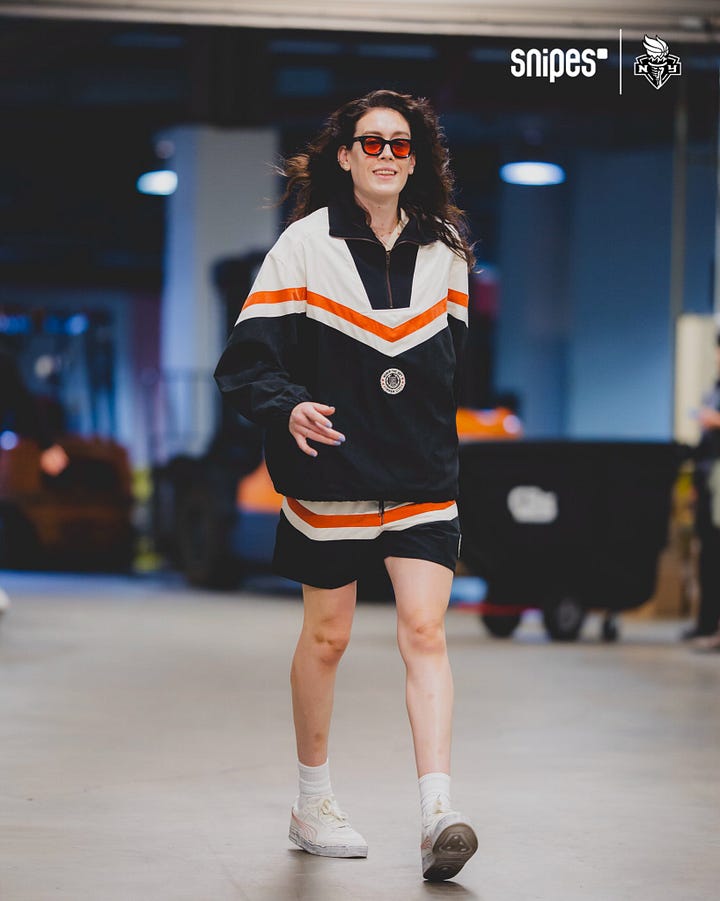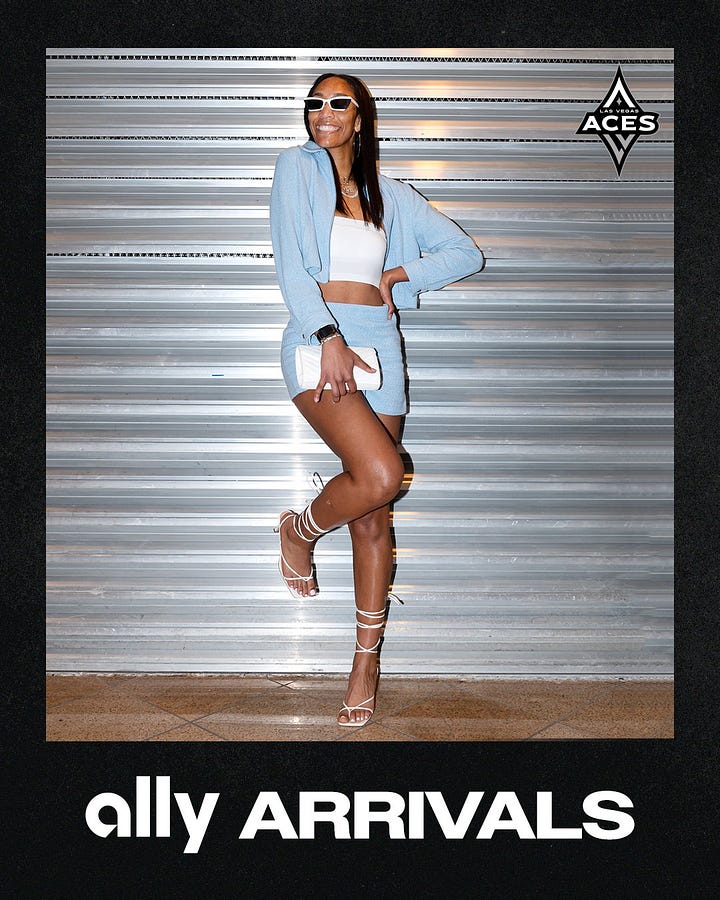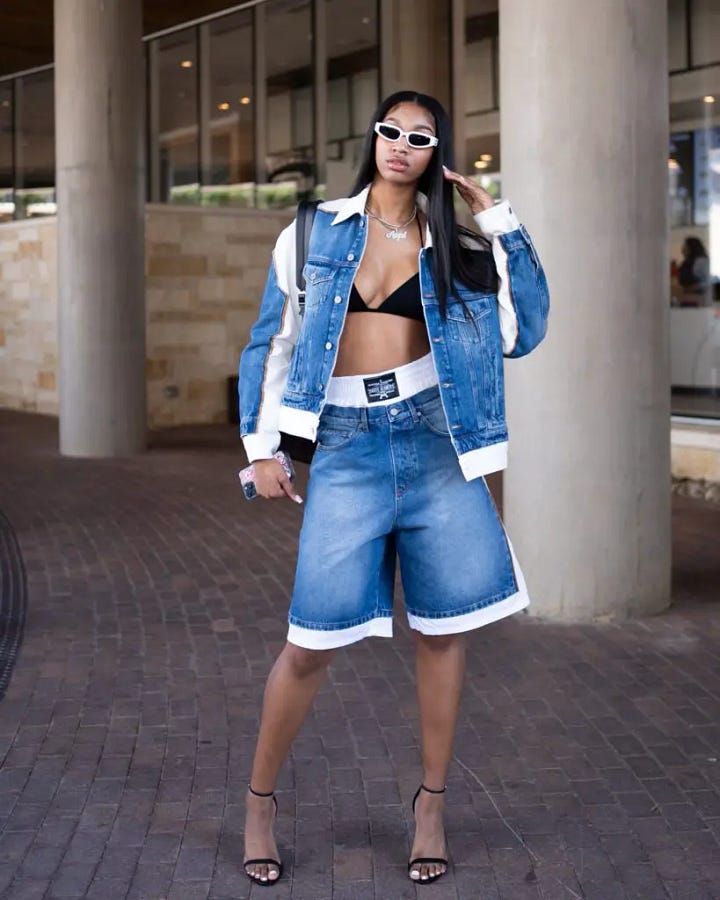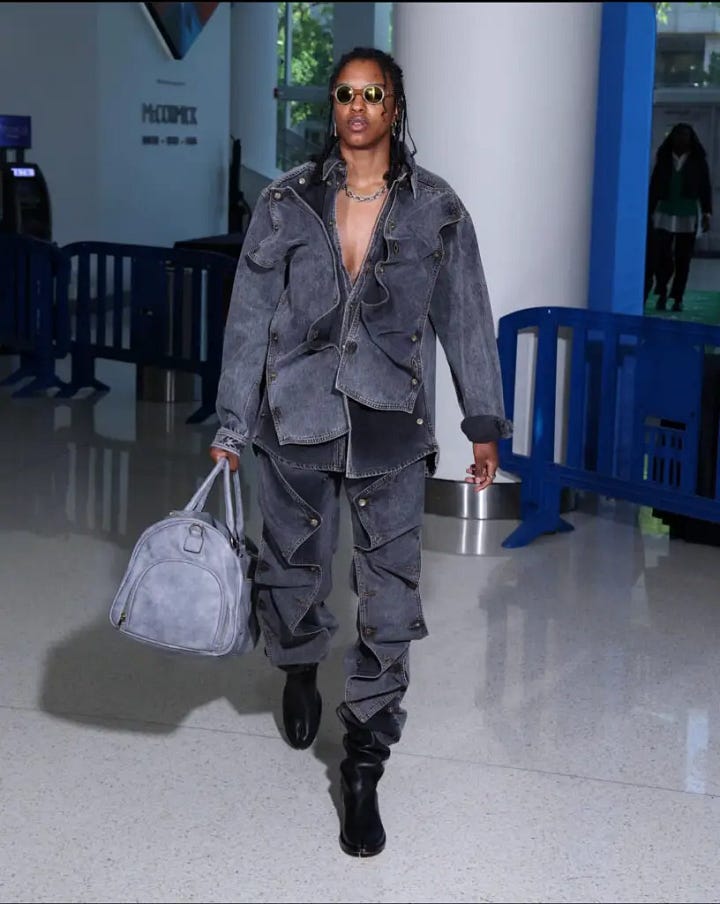walking the impossible tightrope
WNBA tunnel fits, matching sets, and the perpetual self-reconciliation of the female athlete
I should preface this by saying that I have not been as informed and enthusiastic of a fan of the WNBA for as long as I have enjoyed the NBA (or MNBA). (Come back to me in a couple years, though, because I’m diving in!) However, I do feel the need to clarify that I was not solely pulled in by Caitlin Clark’s ascent to household name status. My friend Emilia, who has since moved back to London (miss you!) was a longtime basketball player who took me took me to my first New York Liberty game shortly before she left. Obviously, I am now fully bought in.
As coverage of the WNBA exploded earlier this year, parallel coverage of the players’ tunnel fits proliferated alongside it.1 Several WNBA-specific fashion Instagram accounts have also popped up in the past few years.2 But there are several writers and reporters who have been on the WNBA fashion beat for a long time—namely, Kirsten Chen, and her long-running regular outfit coverage on WNBA.com.
There’s one article by Chen that highlights a certain shift in WNBA style: the ubiquity of the matching set. In the article, Chen outlines Sue Bird’s personal style evolution over her two-decade career. Below is the final image in the piece—two of the three outfits are matching sets.
I found evidence of the matching set in a tunnel fit as far back as 2019, on Tamera Young. Five years later, you’d have a difficult time scrolling through a tunnel fit slideshow without seeing one. (I’m including suits under the umbrella of matching sets, but even so, that only makes up a small percentage.)
Perhaps the most notorious recent matching set in the WNBA was this leather Alexander Wang one, worn by Kelsey Plum before her first game of the season in May. Though Plum didn’t explicitly make this connection, several news outlets (and many fans) characterized it as a “revenge look”, as it came only several weeks after Plum and her NFL player husband filed for divorce. It’s hard to say if a different outfit would have commanded the same attention, even if she looked just as good—the matching set conveys both intentionality and ease.
Another player (now dear to my heart, as a member of the New York Liberty) who loves the matching set is Breanna Stewart.




Clockwise from top left: Breanna Stewart in an Honor the Gift matching set, another Honor the Gift set, floral Teddy Fresh jacket and pants, and yellow Marni shorts and button-down. (Images courtesy of NBA / Getty Images, @nyliberty on Twitter)
A’ja Wilson of the Las Vegas Aces is also a fan.3




Clockwise from top left: A’ja Wilson in a William Bassee black denim set, a red and black leather Heaven Jarrett set, a TIA ADEOLA pink matching set, and a powder blue skirt and jacket set.
So many players make use of the matching set for their tunnel fits—below is only a mere sampling:




Clockwise from top left: Angel Reese in a denim Jean Paul Gaultier set, Diamond DeShields in a Y/Project black denim set, Skylar Diggins-Smith in a white suit (designer unknown! to me at least!), and Sydney Colson in a shorts set designed by Blaine McGowan of Sneaker Politics.
Some people might end there. But if you know me, you’ll know that I couldn’t let the matching set just exist as a trend on its own, without any context or examination!
Just as the NBA has had a fraught relationship with the sartorial self-expression of its players, the WNBA has wrestled with its own issues around ‘appropriate’ dress.4
It’s possible to see the matching set as a bridge between the “business casual” days of the ill-fitted skirt suit or sheath dress and the present-day expression of personal style and individuality. But I think there’s more to it. Maybe the matching set evolved as a way to confront the double-bind of conforming to societal expectations around femininity while also maintaining an image as an elite athlete.
“Women in sports already get trolled for nothing, so of course we also get trolled when our beauty isn’t on point… It's very hard to go to work and do the job that we do and look like a beauty queen.” - Seimone Augustus in Into the Gloss
The matching set communicates that you take yourself seriously, you’re putting some thought into your appearance—but not too much. It’s a wink and a nod to femininity without yielding to all of its trappings. It’s a symbolic attempt to walk the impossible tightrope of expectations placed upon female athletes—lean too far in either direction and you’ll fall.
In 2019, Sports Illustrated shared—almost as an aside—that not too long ago, “WNBA players were asked to sit through hair and makeup classes at rookie orientation.” When these classes were introduced in 2008, a reported one third of orientation was composed of seminars on makeup and fashion. (Brittney Griner declined to participate during her rookie orientation.) Some of the quotes from this Sports Business Journal article are eyebrow-raising—the coach of the Los Angeles Sparks at the time, Michael Cooper, remarked of Candace Parker, “She’s already changed the interest in the WNBA. Hopefully we can get some of those single guys who only watch the NBA to come watch the WNBA.”
In a guest post for the Crunk Feminists Collective Summer McDonald Cross notes, “… if heterosexual men don’t think they can beat you at a sport, they at least want to think they can sleep with you after the game.” - Ebony
That double-bind of projecting both a traditional version of femininity and athleticism becomes even more fraught when you add racism to the mix. The WNBA has few restrictions on hairstyle choices, but does have some rules around adornments (like beads, which are largely the purview of Black women or sunburned white girls who made an ill-advised decision on vacation). Players also receive appearance-related criticism (particularly when they lose!) when they ornament themselves with overtly feminine accoutrements, like fake eyelashes, hair extensions, and long nails—all of which have origins in Black and Latina culture, and are often worn by Black and Latina players.
This toxic intersection of misogyny, homophobia, and racism within the WNBA has been laid bare in the last decade and a half, and there has been progress—to a certain degree—on all of those fronts.
“What you’re seeing is certainly athletes now who, because of the changes we’ve seen in college sport — they all have pride nights, there’s gay marriage now — all these changes that have happened in their lifetime that signal it might be OK to perform their gender in a different way,” [Nefertiti A. Walker, professor in sports management] said.” -New York Times
The WNBA currently has 42 openly queer players, as opposed to just ten years ago, when only a handful of players felt safe enough to publicly define their sexuality. Androgynous style and gender presentation (both within and outside of the WNBA) is more mainstream and socially acceptable—though receptiveness still varies widely depending on the audience, and thin white women have historically been given ‘permission’ to embrace androgyny in a way that other bodies and identities have not.
I would be remiss to end this piece without mentioning how insidious of a role capitalism has played in the development of self-expression in the WNBA. The highest salary in the WNBA right now caps out at $250,000, whereas the minimum salary requirement in the NBA is $1.1 million. While it is now common for both NBA and WNBA players to have paid partnerships and sponsorship deals, WNBA players may rely more on those deals to supplement their salaries in a way that no NBA player would need to do. There is now a clear financial incentive to maintain a public persona that appeals to the masses.
[Cameron Brink] acknowledged that her following — 203,000 on Instagram and 62,800 on TikTok — had built up at least in part “because I do play into that role of being feminine and dressing femininely.”- New York Times
After the 2021 decision to allow name, image, and likeness (NIL) deals in college sports, creating and maintaining an image as a public figure became important even before entering a sport at the professional level. Angel Reese, an LSU grad and rookie on the Chicago Sky (whose starting salary is $73,439), deftly navigated the formation of her own public image to become the player with the second-most NIL deals last year across all sports.
[Bayou Barbie] is a fitting moniker for a player who says she has to have her nails done for every game. Reese swipes on lip gloss before taking the court and applies her eyelash extensions herself. With an eye to endorsement income, she is going through the process of trademarking the name. (She also has a YouTube channel and name, image and likeness deals with Coach and a local law firm.) - New York Times

While Reese’s sense of joy and empowerment in cultivating her image is clear, not all WNBA players want to express themselves in that way, nor should they feel compelled to.
To bring it all back to Caitlin Clark… it’s not lost on me that it took a (very talented, yes—not the point here, though) straight white woman to finally draw overwhelming mainstream coverage of the WNBA. Now that we’re all paying attention, let’s also acknowledge and reward the players who are breaking with convention to dress in a way that fully reflects their identity—whether that is a matching set or a “sleek lil sports bra & some shorts swaggin,” in the words of Courtney Williams (via Twitter). “There’s more than one way to look sexy, and I hope in the future we can tap into that.”

Stay tuned for a (much lighter) follow-up, with many secondhand matching sets for all of us non-WNBA players. (Though, if you are a WNBA player and you’re reading this, let’s talk!)
And if you’re new here, you might also like this:
the joy of the NBA tunnel fit
The first basketball game I ever watched in full was during March Madness in 2019. The reason for my sudden interest was a bracket challenge that the CEO at my previous job had initiated—on the line was a $250 flight voucher. I’d never been a sports person, but I am unfortunately someone who loves to win, and I spent several hours poring over available …
<3 E
Articles I found helpful that weren’t already linked above:
https://www.thecut.com/article/brittney-griner-interview-megan-rapinoe.html
https://www.dapperq.com/2022/05/is-the-wnba-entering-the-fashion-wars/
https://lifestyle.si.com/fashion-beauty/skylar-diggins-smith-embraces-chic-oversized-suit-for-sleek-pre-game-look-01hyk89nc1d7
https://www.wnba.com/news/the-w-in-designer-23-finals-style-face-off-aces-liberty
https://www.wnba.com/news/the-w-in-designer-23-all-star-captains
https://www.yardbarker.com/wnba/articles/wnba_tunnel_fits/s1_17104_40404925
https://www.gq.com/story/arike-ogunbowale-interview
https://www.businessoffashion.com/articles/marketing-pr/wnba-tunnel-walk-angel-reese-caitlin-clark/
https://wwd.com/feature/wnba-fashion-opportunity-1234969505/
https://www.wnba.com/news/the-w-in-designer-flyest-fits-of-the-week-vii
https://www.wnba.com/news/the-w-in-designer-kristine-anigwe-on-ka-originals-the-future-of-fashion-in-the-w/amp
https://www.azcentral.com/story/sports/wnba/mercury/2022/06/17/mercurys-kristine-anigwe-launches-clothing-brand-empower-women/7612178001/
https://www.elle.com/fashion/a60515165/wnba-fashion-caitlin-clark-cameron-brink-rickea-jackson/
(See BoF, Harper’s Bazaar, and WWD, among many others.)
Many players, including A’ja Wilson, often highlight the work of smaller labels and designers of color, particularly Black designers. There’s also a former WNBA player—Kristine Anigwe—who began styling and designing outfits for both her teammates and rivals while she was still playing! Skylar Diggins-Smith in particular has been a big champion of her work, but Anigwe has also dressed Arike Ogunbowale, Azura Stevens, and Diamond DeShields.
The evolution of the actual uniforms for women’s basketball could be a whole other post unto itself.













i'm loving your basketball fashion coverage!! as you mention, many of these women are gay gay gay, and many of them (including some straight ones, imo) are specifically and successfully thirst trapping the lesbian community (reliable and longtime wnba fanbase) with these looks. and god bless them for it!! many of these matching sets reference (or are) menswear, but with elements of playful femininity/queerness mixed in. also i'm seeing that many of these outfits emphasize players' tallness, strong shoulders, muscular arms/legs etc - physical features that are VERY much seen as hot and desirable in queer women's communities. basically, i'm suggesting that many if not most of these outfits are catering to the lesbian (and bi women/nonbinary people!) gaze, haha.
I F*CKING LOVE THIS. Only an expletive could handle my delight. The only thing even better than fashion is fashion + probing + learning. Thank you.